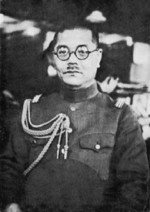Hideo Iwakuro
| Surname | Iwakuro |
| Given Name | Hideo |
| Born | 10 Oct 1897 |
| Died | 22 Nov 1970 |
| Country | Japan |
| Category | Military-Ground |
| Gender | Male |
Contributor: C. Peter Chen
ww2dbaseHideo Iwakuro was born on Kurahashi Jima, Hiroshima Prefecture, Japan in 1897. He attended a military academy in Nagoya, Japan and then enrolled in the Japanese Army Academy, graduating from the latter in 1918. In 1920, as a member of the 16th Infantry Regiment, he saw action during the Siberian Intervention. In 1921, he was transferred to the Japanese Taiwan Army and was stationed in Taichu (now Taichung). He returned to Japan in 1926 and attended the Army War College. Some time during the late 1920s, he joined the Sakura Kai ultranationalist secret society. In 1932, he was transferred to Japanese Kwantung Army in northeastern China. He returned to Japan in 1936 and was later transferred to Army Intelligence to oversee the wiretapping of foreign embassies. In 1937, the No. 9 Army Technical Research Laboratory was established in the Noborito neighborhood of Tama-ku, Kawasaki, Kanagawa Prefecture, Japan, and Iwakuro was involved in the laboratory's projects in the counterfeiting of Chinese currency. In late 1937, he was transferred to the 8th Section of the Army General Staff for the planning of the establishment of a puppet government in China under Wang Jingwei. In 1938, he was one of the most influential members of the committee that established the Army's Nakano School for training intelligence and counter-intelligence agents. Between 1939 and 1941, he was the Chief of Army Affairs Section of the Military Affairs Bureau, in charge of procurement; in this role, he worked with Germany on the sharing of military technologies. During this time, he became a vocal proponent against a possible war with the Soviet Union and for the Greater East Asia Co-Prosperity Sphere. In 1941, he served in the United States as a military attaché and advisor to the ambassador Kichisaburo Nomura, despite Foreign Minister Yosuke Matsuoka's objection toward Iwakuro. In Aug 1941, after Hideki Tojo formed a new government, he returned to Japan to serve as the commanding officer of the 5th Guards Infantry Regiment. When the Pacific War began in Dec 1941, his 5th Guards Infantry Regiment was a part of the 2nd Guards Brigade, which in turn was assigned to the Southern Expeditionary Army Group; with the Southern Expeditionary Army Group, he saw action in Malaya and Singapore. Upon securing Singapore, he was made an liaison officer with the Japanese-backed Indian National Army. In 1943, he was made the Vice Chief of Staff of the 25th Army in Singapore. In 1944, he was the Chief of Staff of the 8th Army in Burma. In 1945, he returned to Japan and was attached to the Army Ordnance Administrative Headquarters. At the time when the Pacific War ended, he was the head of the Army Investigation Department at the rank of major general. After the war, in 1965, together with Toshima Araki, he founded the Kyoto Sangyo University. He passed away in 1970 from a heart attack.
ww2dbaseSource: Wikipedia
Last Major Revision: May 2023
Photographs
 |
Hideo Iwakuro Timeline
| 10 Oct 1897 | Hideo Iwakuro was born on Kurahashi Jima, Hiroshima Prefecture, Japan. |
| 22 Nov 1970 | Hideo Iwakuro passed away in Japan from a heart attack. |
Did you enjoy this article or find this article helpful? If so, please consider supporting us on Patreon. Even $1 per month will go a long way! Thank you. Share this article with your friends: Stay updated with WW2DB: |
» Invasion of Malaya and Singapore
- » 1,150 biographies
- » 337 events
- » 43,897 timeline entries
- » 1,241 ships
- » 350 aircraft models
- » 207 vehicle models
- » 372 weapon models
- » 123 historical documents
- » 260 facilities
- » 470 book reviews
- » 28,524 photos
- » 432 maps
Joachim von Ribbentrop, German Foreign Minister, Aug 1939